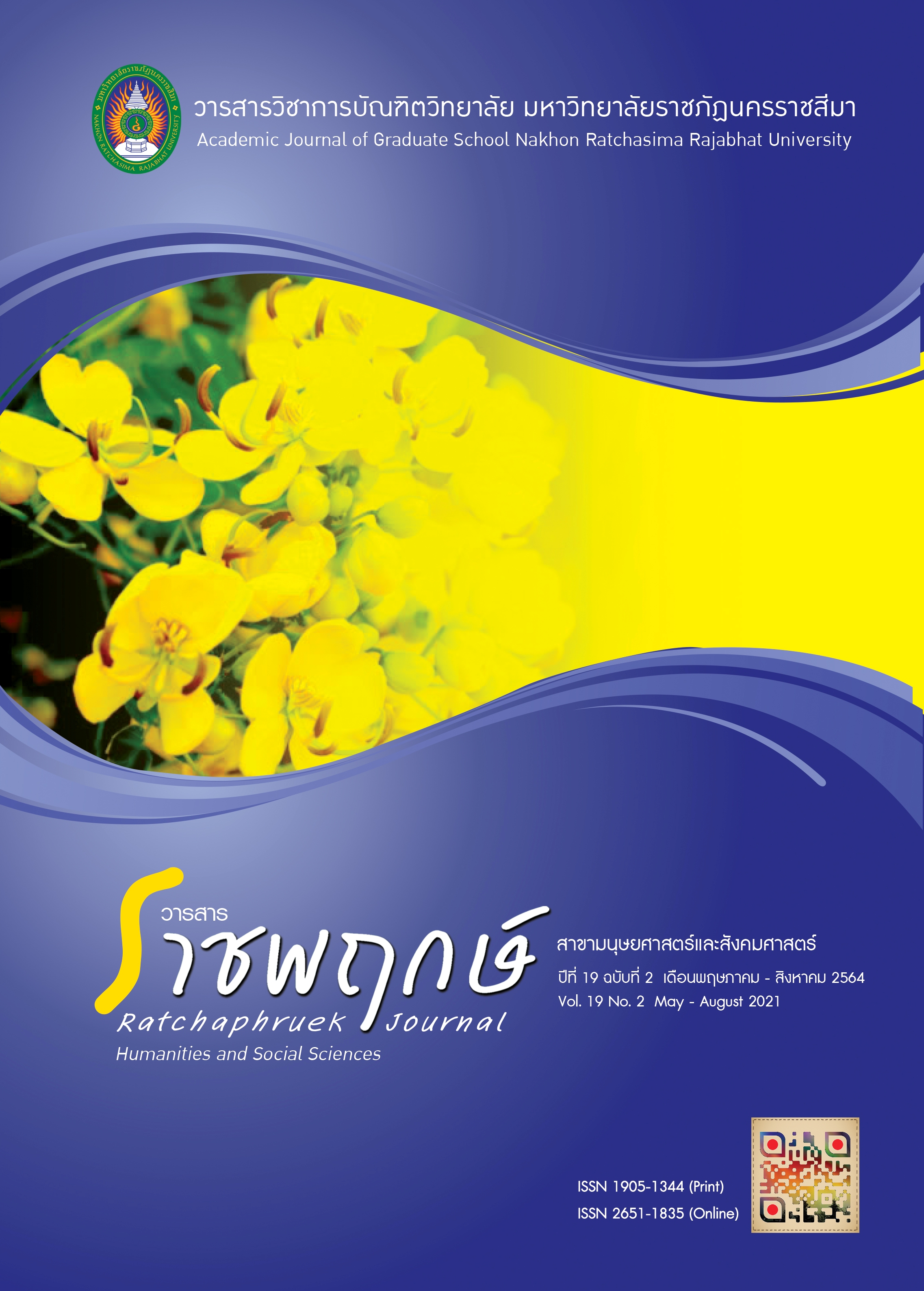The Perceptions and Coping Style of Disaster Victims: A Case Study of Affected People from Earthquake in Phan District, Chiangrai
Main Article Content
Abstract
This study aimed to investigate the level of the perceptions, the coping style, and the factors influencing
the coping style of people who affected by the earthquake event. Population were 122,644 people who are
domiciled and residing in Phan district of Chiang rai. The sample were 354 people who experienced in an
earthquake in May 2014 by multi-stage sample sampling from 6 sub-districts of Phan district. The research
instrument was a questionnaire consisted of two parts including part 1: personal factors and part 2: the six
points summated rating scale questionnaire in the perceptions and the coping style. The data were analyzed
by frequency, percentage, average, standard deviation, pearson product moment correlation coefficient,
and multiple regression.
The results were that the total average of the perceived level and the coping style was at a high level.
Age, income, cognitive toward the earthquakes, thoughts and feelings toward the earthquakes were associated with coping styles. The large effect size were cognitive toward the earthquakes, thoughts and feelings toward the earthquakes and age respectively. All these variables could predict coping style at 61% (R2=0.610). Raw score prediction equation was Y’ = 0.878 + 0.714 (cognitive toward the earthquakes) +0.145 (thoughts and feelings toward the earthquakes) - 0.13 (age).
Article Details
References
กองเฝ้าระวังแผ่นดินไหว. (2557). แผ่นดินไหวจังหวัดเชียงราย. สืบค้นเมื่อ 1 พฤศจิกายน 2563, จาก https://earthquake.tmd.go.th/documents/file/seismo-doc-1422078516.pdf
กองเฝ้าระวังแผ่นดินไหว. (2561). รายงานการเกิดแผ่นดินไหวบริเวณประเทศไทยและพื้นที่ใกล้เคียง พ.ศ.2561. สืบค้นเมื่อ 1 พฤศจิกายน 2563, จาก https://earthquake.tmd.go.th/report/file/seismo-report-1590647002.pdf
กองเฝ้าระวังแผ่นดินไหว. (2563). สถิติข้อมูลแผ่นดินไหวที่มีผลกระทบต่อประเทศไทย. สืบค้นเมื่อ 1 พฤศจิกายน 2563, จาก https://earthquake.tmd.go.th/earthquakestat.html?pageNum_stat=0&totalRows_stat=393
ทับทิม ปัตตะพงศ์, บำเพ็ญจิต แสงชาติ และพูลสุข ศิริพูล. (2562). การรับรู้การเตรียมพร้อมรับภัยพิบัติในเด็กวัยเรียนที่อยู่ในพื้นที่เสี่ยงภัย. วารสารพยาบาลศาสตร์และสุขภาพ, 42(1), น. 43-51.
นวลละออง ทองโคตร, ลำไพร สร้อยทอง, ปทิตตา ภูดิฐวัฒนโชค, สุพจน์ แก้วบุดดี และสุพัตรา กองเพชร. (2556). สภาวะสุขภาพจิตและรูปแบบการเผชิญปัญหาของผู้ประสบภัยอุทกภัย: กรณีศึกษาตำบลพระลับ อำเภอเมือง จังหวัดขอนแก่น (รายงานการวิจัย). นนทบุรี: สถาบันพระบรมราชชนก.
ภาสกร ปนานนท์. (2558). 1 ปี “แผ่นดินไหวแม่ลาว” (ตอนที่ 1) กับอาฟเตอร์ช็อกอีกกว่า 500 วัน-ทำความเข้าใจความแผ่นดินไหว ภัยที่พยากรณ์ไม่ได้. สืบค้นเมื่อ 3 พฤศจิกายน 2563, จาก http://thaipublica.org /2015/05/mae-lao-earthquake.
มาโนช หล่อตระกูล และปราโมทย์ สุคนิชย์. (2552). จิตเวชศาสตร์รามาธิบดี (พิมพ์ครั้งที่ 3). กรุงเทพฯ: บียอนด์ เอ็นเทอร์ไพรซ์.
ราเชนทร์ พูลทรัพย์ และบุญสม วราเอกศิริ. (2560). แนวทางการจัดการตนเองของชุมชนจากผลกระทบของภัยพิบัติทางธรรมชาติด้านแผ่นดินไหวในจังหวัดเชียงราย. วารสารสังคมศาสตร์วิชาการ, 10(1), น. 82-97.
สิริกัญญา สิริสม, เจียมจิต แสงสุวรรณ และจิตภินันท์ ศรีจักรโครต. (2556). ปัจจัยที่มีความสัมพันธ์กับการเผชิญปัญหาในผู้สูงอายุโรคหลอดเลือดสมอง. วารสารประสาทวิทยาศาสตร์ ภาคตะวันออกเฉียงเหนือ, 8(2), น. 70-81.
สุธีกาญจน์ ไชยลาภ และสมบัติ ริยาพันธ์. (2557). การเตรียมความพร้อมทางด้านจิตใจในการรับมือกับภัยพิบัติของประชาชนในกรุงเทพมหานคร. วารสารเกื้อการุณย์, 21(ฉบับพิเศษ), น. 44-58.
สำนักงานคณะกรรมการพัฒนาการเศรษฐกิจและสังคมแห่งชาติ. (2554). การจัดการภัยพิบัติและการฟื้นฟูบูรณะหลังการเกิดภัย กรณีศึกษาประเทศไทยและประเทศอื่นๆ. กรุงเทพฯ: เพชรรุ่งการพิมพ์.
Paaptanti, Duang-ramon. (2558). เด็กๆ คิดอย่างไรเรื่องการลดความเสี่ยงจากภัยพิบัติและการฟื้นคืนสู่ภาวะปกติในเขตชุมชนเมือง. กรุงเทพฯ: เซฟ เดอะ ชิวเดรนด์.
Castañeda, J. V., Bronfman, N. C., and Cisternas, P. C. (2020). Understanding the culture of natural disaster preparedness: exploring the effect of experience and sociodemographic predictors. Natural Hazards, 103, pp.1881–1904.
Dusenbery, D. (2009). Living at Micro Scale. New York: Harvard University Press.
Lazarus, R. S., and Folkman, S. (1984). Stress Appraisal and Coping. New York: Splinger.
Lee, E., and Lee, H. (2019). Disaster awareness and coping: Impact on stress, anxiety,
and depression. Perspectives in Psychiatric Care, 55, pp.311-318.
Onuma, H., Shin, K. J., and Managi, S. (2017). Household preparedness for natural disasters: Impact of disaster experience and implications for future disaster risks in Japan. International Journal of Disaster Risk Reduction, 21, pp.148-158.


